The success of the Power Platform is undeniable. For example, 86% of Fortune 500 companies use Power Apps internally for simple to complex solutions, helping their staff create apps quickly if needed while still leveraging an extensible platform. But the platform is not just for large organizations, as even SMEs can quickly and easily make use of it and create solutions for themselves.
A good amount of Power Apps’ and Power Automate’s success can be attributed to their simplicity as a low-code app platform and usefulness as a workflow platform. They don’t require experienced developers to get started, as staff from all areas of the business can build their own first apps and Flows with only a bit of initial guidance. This helps to get ideas for potential applications started and verified quickly, leading to a rapid innovation cycle.
With more than 500 connectors that allow you to integrate other systems and applications from Microsoft and other companies into your Power Apps and Flows, there are plenty of opportunities to create solutions to automate and improve processes within your organization. These can be simple, personal workflows that help you to automate a daily task, or even complex solutions that integrate with multiple other systems and are to be used by the whole company. Below, we will look at three ways you can specifically integrate Power Automate and Power Apps into your work life.
Automate Your Own Work Activities
As mentioned, the barrier to entry to create your own Power App or Flow is quite low, and usually anyone within an organization is allowed to create their own small solutions. While you could start from scratch, you also have the option of using existing templates that have been made available. For example, when you look at the available Flow templates, you can find hundreds of ready-to-use workflows that you can use to automate specific processes.
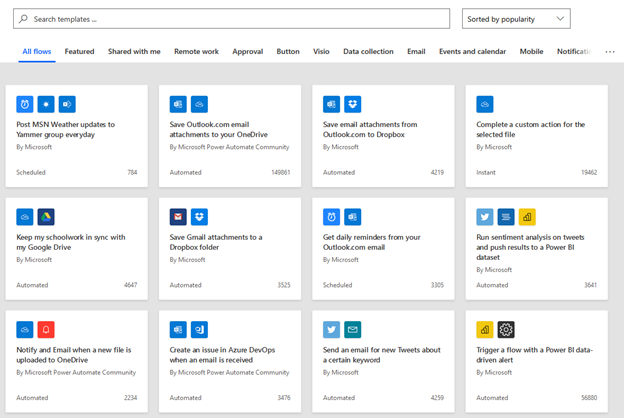
How does this now fit into your daily workflow? Well, that largely depends on what you’re doing on a daily and weekly basis. Not everyone will use Azure DevOps or Power BI, for example, and thus those templates will not be useful. But there are certainly other solutions that will look like a good match for what you are working on and with.
Imagine the following scenario: every day, you receive an email with attachments from another system as part of a reporting process. You then save the attachment into a folder on your laptop and then delete the email. One way you could improve this is by using a template that saves attachments from incoming emails into a specific folder in your corporate OneDrive. With some small updates to the Flow, such as deleting the email after the file has been saved, you’ve then automated a process that was often a distraction for you. Additionally, you could easily share the attachments stored in OneDrive with another colleague.
Of course, you can also go beyond what is available as part of the templates and create your own Flow from scratch. Let’s say you do a few steps every time before you go on leave: you send a reminder to your boss and direct colleagues, post a message into two specific Teams that you are a member of, and set your status to “out of office” in Outlook. Why not automate that?
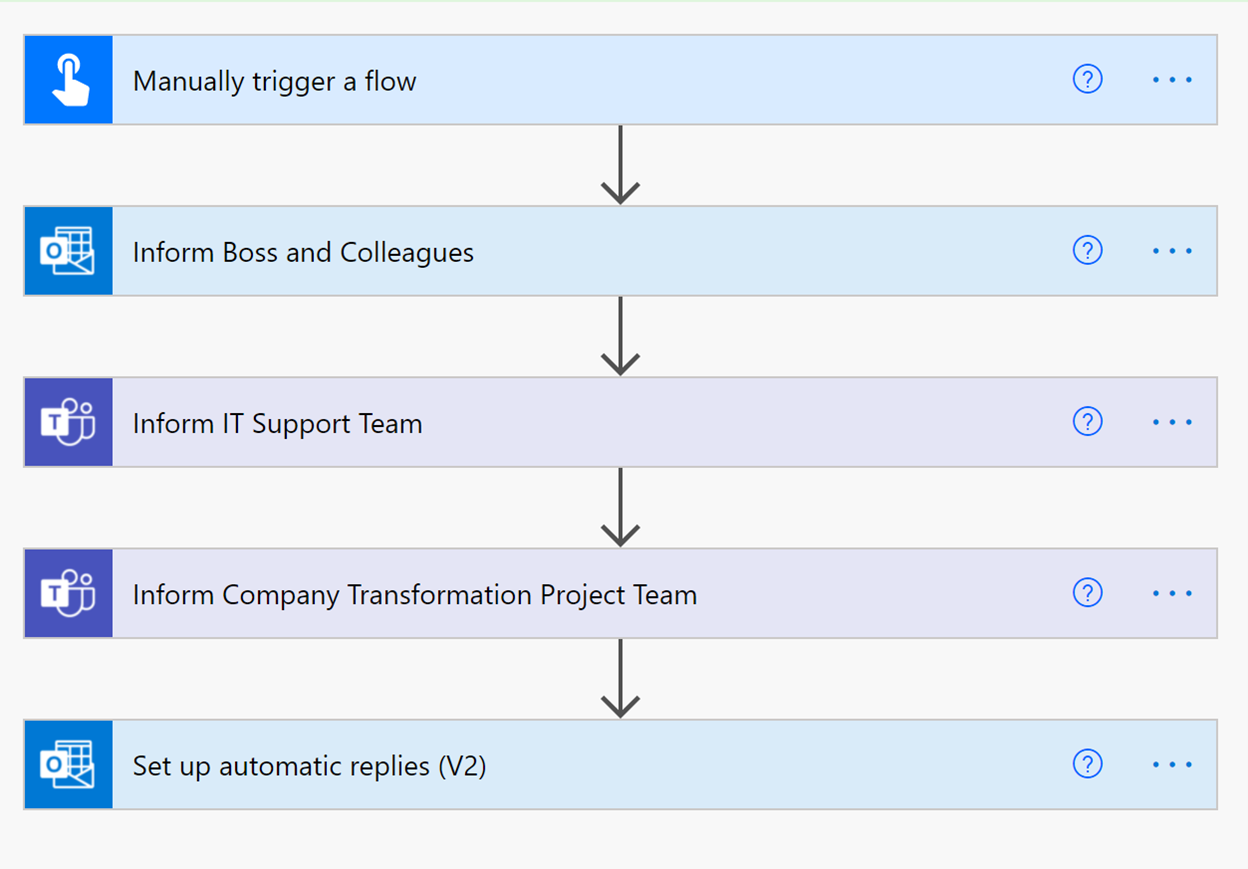
The simplest solution consists of a Flow that sends the email with predefined text to the relevant recipients, posts a standard message into the relevant channels, and finally sets your out of office status. If you wanted to improve this, you could even create a small Power App that captures required details—such as from when until when you are out of the office—and then triggers the Flow which dynamically inserts this information into the corresponding texts.

The goal of these kind of Flows and apps is not to create a perfect solution that works for everyone, but rather to build something small and simple that helps you directly in a specific scenario. The value in those solutions is for you personally, freeing up time that you can spend on other, potentially more important activities.
Improve Your Team’s Processes
Another way to leverage the Power Platform is to go beyond your own needs and look at the processes and tasks your team is working on. Do you want to post a message into a specific Teams channel whenever an Azure DevOps build fails, since you would want to notify the whole team about it? Or do you want to create a new work item whenever an email with the term “bug” in the subject arrives in your team’s support mailbox? Maybe you want to share a weekly summary of opportunities that were created in Dynamics 365 with the corresponding team. Or how about a weekly summary of all new, current, and soon-to-start projects from the SharePoint list you are using to track your department’s projects?
This should give you an idea of what’s possible – besides automating existing processes and thus reducing the overall effort of the people involved (and hopefully allowing them to focus on other, value-adding activities), you can also look for additional opportunities that can help your team, like being able to share or surface important information for them. The daily or weekly summary emails, whether it’s for new projects, new sales opportunities, or others, can help to give the team a better understanding of what is happening currently.
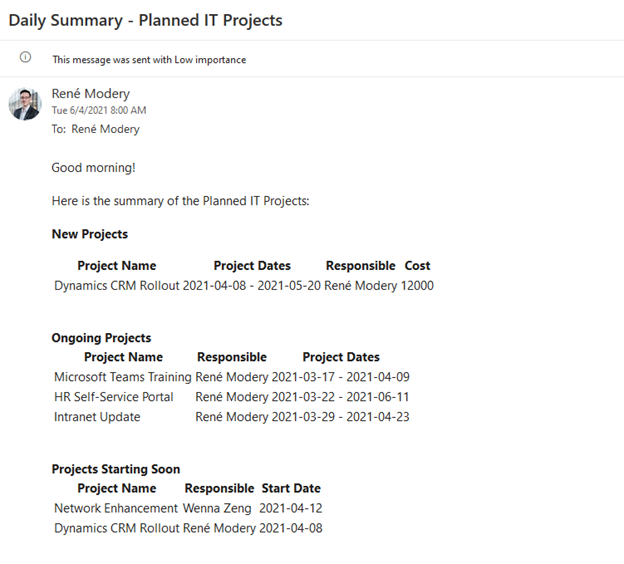
The screenshot above is a simple example of a daily summary email that gets its data from a SharePoint list. While the formatting is kept relatively simple here (and could of course be improved to something more visually appealing), the purpose and value of it is quite clear: With one quick look, relevant stakeholders of the IT department’s projects get an overview of any new or current projects and are thus aware of the main focus of this week. To maintain the data, you could create a dedicated Power App that helps with data entry and maintenance. And of course, you could easily use Power BI to visualize relevant information (ex. if you are tracking budget estimates and actual expenses).
Besides building your own solution, you can, once again, also leverage existing templates from Microsoft. There are a couple of interesting and useful Power Apps templates that can help you get started. For example, if you are planning to track your IT department’s assets, such as portable meeting speakers, external monitors, keyboards, extra laptops, or something similar, you could make use of the Asset Checkout template:
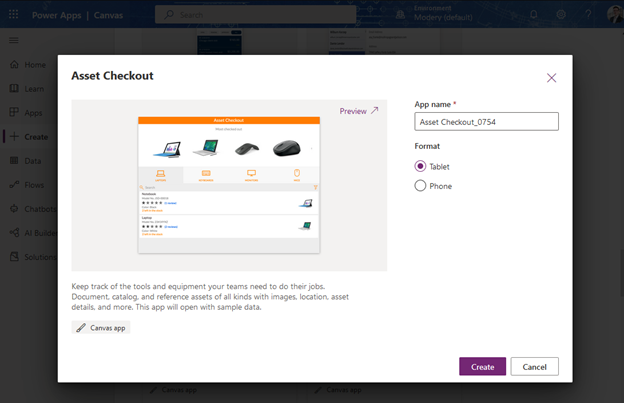
This solution even allows staff to check out items in case they need them!
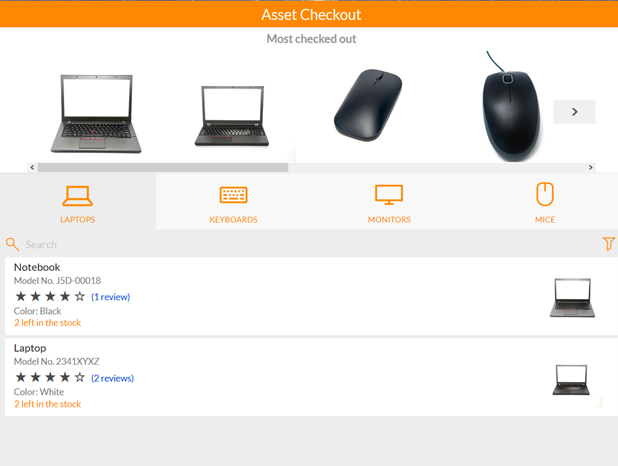
It should be clear by now that these kinds of solutions are usually a bit more complex than the previously mentioned personal solutions: they may require multiple components (a specific location where data is stored, an app, potentially multiple Flows, …), take a few days or even a few weeks to develop, and generally have a larger audience. While one person could create these kinds of solutions, they may also require additional help. Often, these kinds of solutions are built by a small team, consisting of people from IT as well as the department that requires the solution.
With its rapid prototyping capabilities, Power Platform allows the business stakeholders to quickly see a working version, letting them influence further development and steer it towards a successful solution. Additionally, instead of only relying on “professional” developers to create a solution, they can even start working on a prototype themselves first and collaborate on an improved solution together with the IT developers at a later stage.
Create Company-Wide Solutions
Lastly, there are the Power Platform solutions that need to be developed by a dedicated team of Power Platform developers. Instead of only looking at a smaller group of people, these kinds of solutions are generally targeted at a bigger number of staff or even the whole company. Compared to the previous category, they are usually also much more complex. They may connect to other external systems or APIs, require more advanced security controls, are subject to specific regulatory controls, have a higher financial impact, require custom coding, or have other similar criteria.
The impact of these solutions has the potential to be fairly large, and thus the corresponding projects generally require closer oversight than the previous two categories. However, if the stakeholders involved in these projects already have experience in creating their own, albeit smaller Power Platform solutions, there exists an opportunity for them to provide better, more targeted input and feedback to the development teams. Knowing how something similar can get done in a simpler scenario, and understanding the capabilities and possibilities of the platform, can help to contribute to the project’s success.
Conclusion
As we have seen, Power Platform can help organisations of all sizes in many different ways. It can be integrated into an individual employee’s daily work life to automate his activities or improve his processes, it can be used to support teams with advanced solutions, and it can be part of the toolbox used by development teams to create “professional” solutions. This is not to say that any of these approaches are better than the others, or that there is a preferred one among those. Rather, it demonstrates the flexibility and strength of the Power Platform, and how companies can integrate it into their workforce’s daily life.




